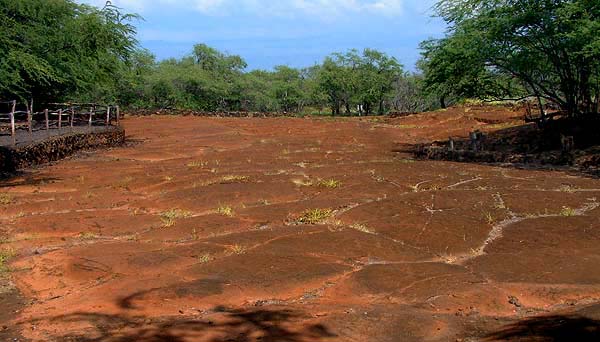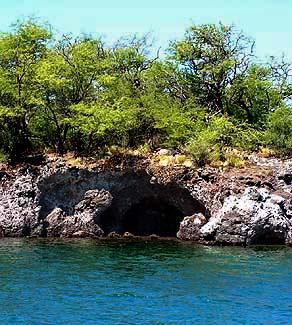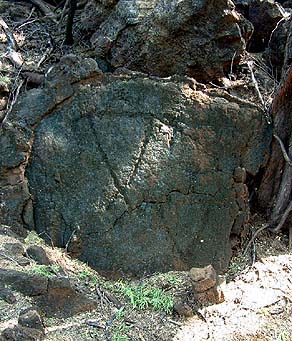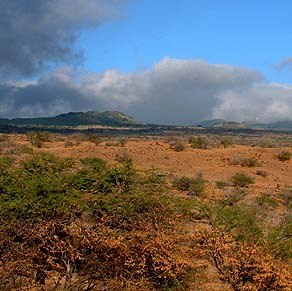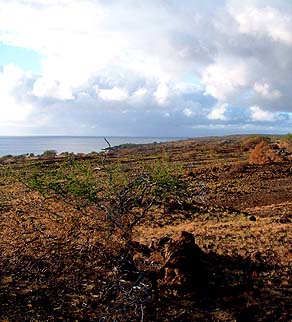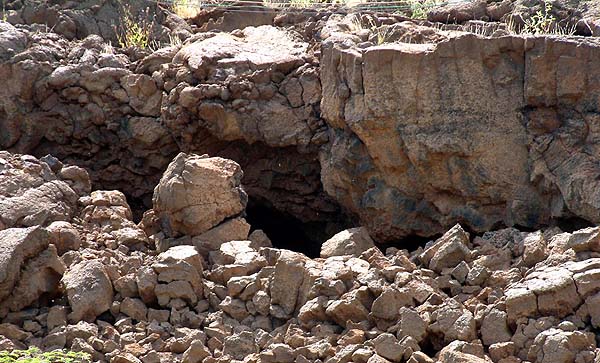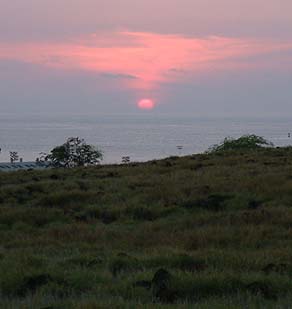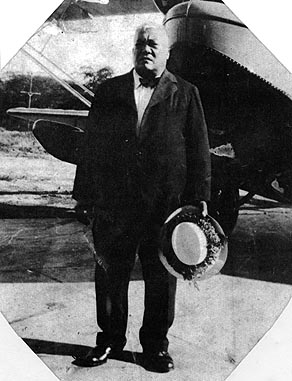 |
 |
 |
|||||
|
|
|||||||
|
|
|||||||
| |
|
|
|
|
“The Kawaihae people had a burial cave that used to be at the end of Puako," Ku‘ulei says. "They have found that cave and it’s been damaged. People have gone in and taken things and broken things, and left a lot of beer bottles and stuff like that, so there’s not much left of there. There were quite a few burial caves. “My dad said a funeral was an all-day thing, because they would take the body from Kawaihae on the boat all the way to Puako and drop it off, and the boat would come back and get the people and take them. So all day long the boat is going back and forth. Maybe around mid-day everybody’s there, and then they start going."
|
||
|
|
||
"And then there was a man from Kawaihae who used to be the one who would go and open the cave. And my dad said he remembers going with him. My dad said he would open the cave, but, he said ‘It’s a key thing.’ He said, one rock and the whole thing crumbles, and he said then this man puts it all back together, covers the cave. “But then they would go there and view the body, have the service, and then after everybody goes, he’ll put the body into the cave and close the cave up and the boat would come back. He was the last guy. And after that he’d get in the boat and come back to Kawaihae. So my dad said a funeral was an all-day thing. “I don’t know what happened to all the people that were there. I don’t know if the families came and got them, or the bones just dried up and disappeared, but my dad said that he remembers quite a few people there."
|
|
|
“At Puako there is a big burial cave,” Papa agrees, “but there’s supposed to be a caretaker. Because after the body’s been laid in there for many, many years, what they do, they collect all the bones and stuff like that, and put them together and they get, just like the mail boxes at the Post Office. There’s a ledge. So they put all the bones inside there. "That’s the one at Puako. I never see that cave, so I don’t know. But there’s others I went in, further down, Keawaiki and all those other places. Big lava tubes. And you see burials there on the shelf.” “That’s just beyond Puako,” Billy says. “I’m not a spelunker but I have a hunch where it is. You have all that petroglyph field there.Then just recently there was a little bit about the cowboy cave, which is near that Waikoloa area. They were saying that a man was buried in there with his cowboy hat on. "That came up in the papers a few weeks ago. I had a call from a reporter, if I knew anything about it. I said, 'Well, as far as I’m concerned, I’m a firm believer in those burial caves should all be sealed. Keep people out of them.’”
|
|
|
|
“By the road between here and Mahukona,” Louie says, “when you go up by the bend, get plenty caves up there. Honokoa, and the other side go up.” “You gotta go up, from up you gotta come down,” Pua explains. “And the person who can do that is the one that knows how to get in and out of that cave. And in this cave, there’s a canoe. There’s walking boots, cowboy boots, there’s all kind of things in this cave. The person that could open the cave, he’s no longer here. He’s back up in heaven. There was a password that you needed to say to this cave when you go, in order for that to open up. "And when you get into the cave, they say it’s all water, and certain part, there’s like a platform, I guess it was made that way, or whatever. And that’s where you find all these different things. I never went in, but they tell me it is beautiful in there, that you have a peace of mind, and I believe them. Everything is clear, you can just think clear and look at all those things they have in there, providing you don’t touch, you don’t take what doesn’t belong to you."
|
||
|
|
||
“And why I know this, this man from a museum near here went around in different caves. He'd hear people talking about different caves and he'd ask questions, and they'd show him where it is.” “This guy from that museum,” Louie adds, “somebody showed him, they took him down with a rope and they get this ledge. All the bodies, the bones, he would crawl over. He didn’t care how he did it. Then when nobody was around, he’d go down himself and take them.” “He'd go in there and take things from there” Pua nods. “Now, you don’t touch things that don’t belong to you. Well, he took several things from there, and he had to return them. Because he said at night he can hear these rocks, or whatever he took, fighting among the rest of the things in his house. And he had to return them. You never touch anything that don’t belong to you, and if you want to, you need permission from whoever is responsible for these different caves."
|
|
|
“My cousin next door, when he was still living, he took one boot from this cave, and because he only took one boot, that boot haunted him for months. He couldn’t figure out, he used to hear this boot say, ‘Where’s my partner? Why you take only me? Where’s my partner?’ Until he finally remembered that he had a boot that he took out of the cave, and he had to return it. “Any time you enter a cave, whatever is in there should stay put. Nobody should remove anything from that cave, unless you have permission by an authority that knows what they are doing. But my personal feeling, what doesn’t belong to you, you don’t touch. Leave things alone and you’re not going to get into trouble. But if you think you’re too smart, like this guy over here.... If he had taken the two boots, he wouldn’t have had a problem, but he only took one."
|
|
|
|
|
"Before they built the Waikoloa hotel," Mel recalls, "we had researchers and attorneys and stuff over there. So we went over there and looked over the caves to see what could be documented, but of all the caves, I think there were only two caves that had anything inside, that we knew. So some of the guys sealed them up—you no can see them. "This guy who is supposed to be family, he knew that us guys have family over there in Puako, inside that heiau. He found that cave from one dream, a dream that said ‘Follow the wire, at the end of the wire, move one rock over there at the end of the wire.’ And one day he went, he followed this telephone wire that was on top of the wall and at the end of the wire he looked down and he moved the rock, and there was like the opening of the cave. "So he went in and he looked at it and then, he says, he thought about me because he knew we have family over there. He wanted me to go take a look, and after I had looked, then we didn’t ask questions, we could seal the place up."
|
||
|
|
||
"My grandmother is buried below Pu‘u Kohola and between Pu‘u Kohola and the hotel, Maunakea. One time I took my daughter back there to look at it, and then the following year she went down there with her sister and brother and the two brothers. "They went on for a look at Tutu’s grave and they didn’t find any—looked and looked, and finally I my boy Mel told my daughter, ‘Why don’t you ask Tutu? You know, you’re walking all around this place for nothing.’ "So she stopped, she called Tutu, ‘Eo, Tutu,’ and a soft wind came down and laid all the grass down to Tutu’s grave. She dropped to her knees and she cried, knowing that they’re still around. They get, we say, ‘chicken skin.’"
|
|
|
“My grandfather died in Honolulu in ’41. I was going to Farrington School there at the time. So we made arrangements to take his remains back to Kawaihae. "He always came to Honolulu by boat, and he was one of the first to fly by seaplane from Kawaihae to Honolulu. My Grandfather was fluent in Hawaiian and English. I remember that he enjoyed reading in both languages. He farmed, he built stone walls, made fish nets…he was always a busy man. "My grandfather, he was a well dressed man. When he went out, he was very particular about what he wore. Wherever he went, he had a black suit on, he was dressed up with his bow tie—da kine butterfly tie—and with his hat. At the horse races he was always in his dark suit and black bow tie. That’s his presence. And they all respected him. Now there was one special place on the Humu‘ula where he’d always sit down. So they put his coffin down there in that place. "And from the time that boat left Honolulu, until the boat landed in Kawaihae, it was like that boat was in a stream. Everybody felt it, just like this ali‘i was coming home."
|
|
|
|
“We got in to Kawaihae about 4:30 in the morning, and lo and behold, there was plenty people down there, most of them in white, everybody holding lanterns. They all came to honor my grandfather. Oh, we were choked by it. Then when they lowered his coffin down, the ship boat was blowing the horn slow, tooooooot, tooooooot. When his body got to the ground, you could hear the wailing. That type of wail you don’t hear today. That experience down there was something.”
|
||
|
|
||
Like many practices, burials changed with the coming of Westerners and their culture to the Islands. We now turn our attention to such visitors.
|
||
|
|
||
|
|
|
|
|
|

|
| Kawaihae Home | Map Library | Site Map | Hawaiian Islands Home | Pacific Worlds Home |
|
|
|
|
|
|
|||
| Copyright 2006 Pacific Worlds & Associates • Usage Policy • Webmaster |
|||
